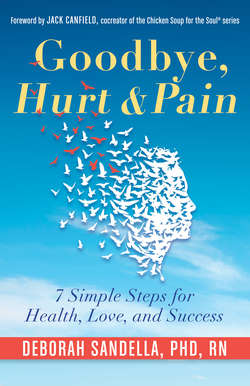Читать книгу Goodbye, Hurt & Pain - Deborah Sandella - Страница 25
На сайте Литреса книга снята с продажи.
Sadness and Grief
ОглавлениеAnother set of often dammed feelings is sadness/grief. Who wants to be sad or grieve? No one. Most of us try to avoid these two related feelings at all costs. But sadness and grief are inevitable in this life. Some of us may have more than our share and some less, but it's impossible to live life without them. We all understand loss is a part of living. However, we play games to trick ourselves into believing we can transcend sadness and grief. Though this path may seem to be the high road at the time, it does not take into account the body's reaction—remember, emotional pain is a physical experience. This visceral response to discomfort is the nervous system preparing the body to react to stress or an emergency. You may think, “I'm okay,” but your body is still processing the experience in its own way.
Sadness and grief are sometimes interchangeable, but they usually differ in duration. Sadness can last a few minutes to a few hours and represents a normal response to perceived and actual loss. Grief usually lasts a few weeks to a few years and involves various states of mind over the course of its resolution. Sadness, if extended, may become grief, and grief includes many feelings of sadness.
Putting a name to these feelings makes them sound almost simple: “sadness and grief,” so neat and tidy. Of course, nothing could be further from the truth. The internal, subjective experience of loss is indescribably painful—it's the realization that our life can change in a split second and we can lose what we have held close to keep us safe and happy. Grief shatters our illusion of control and involuntarily reveals feelings of helplessness.
Early in my career, a bright, kind thirty-year-old woman I will call Jane taught me a great deal about sadness and grief. Years after her father's death, she was still holding on to the sadness; it was such a strong influence she found herself unable to develop a long-term romantic relationship. As she looked deeply into her connection with her deceased dad, two things became clear. First, she had a wonderfully close rapport with him and he had been her biggest cheerleader. Second, she was clinging to the sadness because it was all that was left of him in a worldly way; it was their last physical connection. She was stuck in a dead feeling about her most loving relationship and unable to move past it because if she did, she thought she would lose what little was left.
As Jane delved deeper, she was able to find the energy of her dad's love permanently imprinted in her heart. By tuning in to her feelings, she could reconnect with his undying affection whenever she chose. Freed from grief, her heart opened. She had her personal cheerleader back. His love again supported her to enjoy life and welcome intimacy with a romantic partner.
Before long, Jane met an attractive young man, fell in love, married, and had a child. It was natural and very tender. She had recovered the feeling of her dad's unconditional love. We both learned that love does not end with physical death.
Elizabeth Kübler-Ross eloquently discerned that grief is a natural process in which we move through five stages: denial, anger, bargaining, depression, and acceptance. When and how we move through each stage is spontaneous and personal. And even though we may wish to avoid all the messiness of it, the body needs to process the experience regardless of what we think. Whether the loss is through death, divorce, rejection, firing, or something personal, the five stages still apply.
